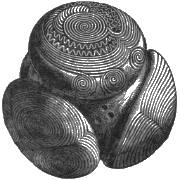Canmore Site 22283: CNOC NA SROINE, MULL - KILNINIAN AND KILMORE - DUN (PERIOD UNASSIGNED)
Description
| Site Name | CNOC NA SROINE, MULL |
|---|---|
| Other Name(s) | CAISTEAL NA SRIANGA |
| Site Number | NM54SE 2 |
| Broad Class | DOMESTIC |
| Site Type(s) | DUN (PERIOD UNASSIGNED) |
| NGR | NM 5553 4330 |
| NGR accuracy | NGR given to the nearest 10m |
| Local Authority | ARGYLL AND BUTE |
| Parish | KILNINIAN AND KILMORE |
| Record created | 1988-03-28 |
| Last updated | 2012-11-20 |
Archaeology Notes
NM54SE 2 5553 4330.
(NM 5552 4330) Fort (NR)
OS 1:10,000 map, (1976)
When visited in 1972, this monument (previously published as 'Castle') was described as a fort, (though its dimensions - as given by the RCAHMS - were more appropriate for a dun). It was in a similar condition to that described by the RCAHMS.
Surveyed at 1:10,000.
Visited by OS (D W R) 3 May 1972.
The conspicuous remains of a dun and what has probably been an outwork occupy the summit of Cnoc na Sroine (130m OD). Oval on plan, the dun measures 28m by 19m within a wall 3m thick. Considerable stretches of both the inner and outer faces can still be seen. The former is best preserved on the S, where it stands 1.6m high in eight courses and exhibits a marked batter; the best surviving portion of the latter occurs on the SW, where it attains a height of 1.1m in six courses. The entrance, situated on the WSW, is about 1.8m wide, and the lowest course of the entire N passage-wall, including a check for a door, can still be seen. The interior contains no traces of buildings.
The natural rocky shelf lying on the SW of the dun is bordered in places by a thin scatter of core material from a dry-stone wall; no facing-stones can be seen in position, but a number of larger blocks, which may originally have served such a purpose, lie dislodged among the debris. Although the relationship between this wall and the main work cannot be demonstrated without excavation, the curious angle that it makes to the SE of the dun strongly suggests that the wall did not enclose the highest point of the dun, and it is therefore more likely to represent the remains of a contemporary outwork.
A 'fine brooch' of unknown date is said (Duns 1883) to have been found amongst the ruins, but it was subsequently lost. A plano-convex flint scraper, which was found on the date of visit in a molehill just outside the outwork on the SE, has been donated to the National Museum of Antiquities of Scotland (NMAS).
RCAHMS 1980; J Duns 1883.
Identifiers and Links to Other Records
Would you like to help find more links?
| Identifier / External Link | Linked Record | Status | Comment |
|---|---|---|---|
| Canmore Site Number (legacy): NM54SE 2 | No linked record | ||
| NMS Primary Reference: 132603 | X.FC 5 - Penannular brooch | Possible | The site can contain several Viking brooches found on Islay |
This area is visible only to logged in users.
